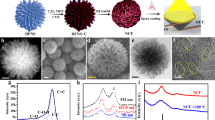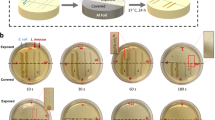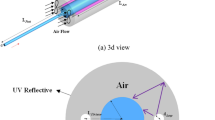Abstract
Bacterial biofilms are problematic wherever water contacts with surfaces. Although germicidal ultraviolet (UV)-C irradiation effectively inactivates microorganisms in flowing water, controlling surface biofilms is challenging due to light delivery limitations within enclosed and flowing water systems. Here, to overcome this, we developed a novel method using UV-C light-emitting diodes connected to side-emitting optical fibres (SEOFs) placed directly on metal surfaces. Targeting mixed-bacterial biofilms from the International Space Station where biofilms threaten critical water systems for astronauts, we successfully inhibited biofilm growth by delivering UV-C light at 265 or 275 nm with an irradiance of >10 µW cm−2 via SEOFs. In contrast, UV-A or UV-B at the same irradiance did not prevent biofilm growth. Energy-efficient intermittent UV-C duty-cycling experiments demonstrated that 10 min of irradiation followed by 50 min of dark time achieved equivalent results to continuous light exposure. Our research highlights the potential of SEOF technologies emitting UV-C light for effectively combating undesired biofilms in water systems.
This is a preview of subscription content, access via your institution
Access options
Subscribe to this journal
Receive 12 digital issues and online access to articles
$99.00 per year
only $8.25 per issue
Buy this article
- Purchase on Springer Link
- Instant access to full article PDF
Prices may be subject to local taxes which are calculated during checkout





Similar content being viewed by others
Data availability
All data are presented in the article and its supplementary information. Source data are provided with this paper.
References
Costerton, J. W. et al. Bacterial biofilms in nature and disease. Annu. Rev. Microbiol. 41, 435–464 (1987).
Laspidou, C. S. & Rittmann, B. E. A unified theory for extracellular polymeric substances, soluble microbial products, and active and inert biomass. Water Res. 36, 2711–2720 (2002).
Flemming, H.-C. et al. Who put the film in biofilm? The migration of a term from wastewater engineering to medicine and beyond. npj Biofilms Microbiomes 7, 10 (2021).
Yao, Y. & Habimana, O. Biofilm research within irrigation water distribution systems: trends, knowledge gaps, and future perspectives. Sci. Total Environ. 673, 254–265 (2019).
Falkinham Joseph, O., Hilborn Elizabeth, D., Arduino Matthew, J., Pruden, A. & Edwards Marc, A. Epidemiology and ecology of opportunistic premise plumbing pathogens: Legionella pneumophila, Mycobacterium avium, and Pseudomonas aeruginosa. Environ. Health Perspect. 123, 749–758 (2015).
McLean, R. J. C., Cassanto, J. M., Barnes, M. B. & Koo, J. Bacterial biofilm formation under microgravity conditions. FEMS Microbiol. Lett. 195, 115–119 (2001).
Kim, W. et al. Spaceflight promotes biofilm formation by Pseudomonas aeruginosa. PLoS ONE 8, e62437 (2013).
Zea, L. et al. Design of a spaceflight biofilm experiment. Acta Astronaut. 148, 294–300 (2018).
Yang, J. et al. Longitudinal characterization of multispecies microbial populations recovered from spaceflight potable water. npj Biofilms Microbiomes 7, 70 (2021).
Adam, N. et al. Update on feasibility of UV LEDs in a spacecraft wastewater tank application. In 2020 International Conference on Environmental Systems (ICES, 2020).
Petala, M., Tsiridis, V., Darakas, E. & Kostoglou, M. Longevity aspects of potable water disinfected by ionic silver: Kinetic experiments and modeling. Water 12, 258 (2020).
Smith, S. M. et al. Benefits for bone from resistance exercise and nutrition in long‐duration spaceflight: evidence from biochemistry and densitometry. J. Bone Miner. Res. 27, 1896–1906 (2012).
Meyer John, A., Seidel Chad, J. & Summers, R. S. Evaluation of population-weighted risk reduction for several disinfection by-product control strategies. J. Environ. Eng. 146, 04019131 (2020).
Petala, M. et al. Silver deposition on wetted materials used in the potable water system of manned spacecrafts. In 46th International Conference on Environmental Systems (ICES, 2016).
Thompson, A. F. et al. Characterizing species interactions that contribute to biofilm formation in a multispecies model of a potable water bacterial community. Microbiology 166, 34–43 (2020).
Sobisch, L.-Y. et al. Biofilm forming antibiotic resistant Gram-positive pathogens isolated from surfaces on the international space station. Front. Microbiol. 10, 543 (2019).
Yang, J. et al. in Methods in Microbiology Vol. 45 (eds Gurtler, V. & Trevors, J. T.) 3–26 (Academic Press, 2018).
Beck, S. E. et al. Comparison of UV-induced inactivation and RNA damage in MS2 phage across the germicidal UV spectrum. Appl. Environ. Microbiol. 82, 1468–1474 (2016).
Beck, S. E., Wright, H. B., Hargy, T. M., Larason, T. C. & Linden, K. G. Action spectra for validation of pathogen disinfection in medium-pressure ultraviolet (UV) systems. Water Res. 70, 27–37 (2015).
Poepping, C., Beck, S. E., Wright, H. & Linden, K. G. Evaluation of DNA damage reversal during medium-pressure UV disinfection. Water Res. 56, 181–189 (2014).
Dotson, A. O., Rodriguez, C. E. & Linden, K. G. UV disinfection implementation status in US water treatment plants. J. Am. Water Works Assn. 104, 77–78 (2012).
Beck, S. E., Hull, N. M., Poepping, C. & Linden, K. G. Wavelength-dependent damage to adenoviral proteins across the germicidal UV spectrum. Environ. Sci. Technol. 52, 223–229 (2018).
Beck, S. E. et al. Wavelength dependent UV inactivation and DNA damage of adenovirus as measured by cell culture infectivity and long range quantitative PCR. Environ. Sci. Technol. 48, 591–598 (2014).
Jones, D. L. & Baxter, B. K. DNA repair and photoprotection: mechanisms of overcoming environmental ultraviolet radiation exposure in halophilic archaea. Front. Microbiol. 8, 1882 (2017).
NASA Technology Roadmaps TA 10: Nanotechnology (NASA, 2015).
Linden, K. G., Hull, N. & Speight, V. Thinking outside the treatment plant: UV for water distribution system disinfection. Acc. Chem. Res. 52, 1226–1233 (2019).
Sholtes, K. A. et al. Comparison of ultraviolet light-emitting diodes and low-pressure mercury-arc lamps for disinfection of water. Environ. Technol. 37, 2183–2188 (2016).
Loeb, S. K. et al. The technology horizon for photocatalytic water treatment: sunrise or sunset. Environ. Sci. Technol. 53, 2937–2947 (2019).
Chen, J., Loeb, S. & Kim, J. H. LED revolution: fundamentals and prospects for UV disinfection applications. Environ. Sci. Water Res. Technol. 3, 188–202 (2017).
Ma, B. et al. Inactivation of biofilm-bound bacterial cells using irradiation across UVC wavelengths. Water Res. 217, 118379–118379 (2022).
Torkzadeh, H., Zodrow, K. R., Bridges, W. C. & Cates, E. L. Quantification and modeling of the response of surface biofilm growth to continuous low intensity UVC irradiation. Water Res. 193, 116895 (2021).
Rittmann, B. E. & McCarty, P. L. Environmental Biotechnology: Principles and Applications (McGraw-Hill Education, 2001).
Ciofu, O., Moser, C., Jensen, P. Ø. & Høiby, N. J. N. R. M. Tolerance and resistance of microbial biofilms. Nat. Rev. Microbiol. 20, 621–635 (2022).
Bak, J., Ladefoged, S. D., Tvede, M., Begovic, T. & Gregersen, A. Disinfection of Pseudomonas aeruginosa biofilm contaminated tube lumens with ultraviolet C light emitting diodes. Biofouling 26, 31–38 (2010).
Friedman, L., Harif, T., Herzberg, M. & Mamane, H. Mitigation of biofilm colonization on various surfaces in a model water flow system by use of UV treatment. Water Air Soil Pollut. 227, 43 (2016).
Kolappan, A. & Satheesh, S. Efficacy of UV treatment in the management of bacterial adhesion on hard surfaces. Polish J. Microbiol. 60, 119–123 (2011).
Lakretz, A., Ron, E. Z. & Mamane, H. Biofouling control in water by various UVC wavelengths and doses. Biofouling 26, 257–267 (2010).
Song, Y., Ling, L., Westerhoff, P. & Shang, C. Evanescent waves modulate energy efficiency of photocatalysis within TiO2 coated optical fibers illuminated using LEDs. Nat. Commun. 12, 4101 (2021).
Ling, L. et al. Coupling light emitting diodes with photocatalyst-coated optical fibers improves quantum yield of pollutant oxidation. Environ. Sci. Technol. 51, 13319–13326 (2017).
Lanzarini-Lopes, M. et al. Nanoparticle and transparent polymer coatings enable UV-C side-emission optical fibers for inactivation of Escherichia coli in water. Environ. Sci.Technol. 53, 10880–10887 (2019).
Lanzarini-Lopes, M., Zhao, Z., Perreault, F., Garcia-Segura, S. & Westerhoff, P. Germicidal glowsticks: side-emitting optical fibers inhibit Pseudomonas aeruginosa and Escherichia coli on surfaces. Water Res. 184, 116191 (2020).
van Tongeren, S. P., Roest, H. I., Degener, J. E. & Harmsen, H. J. Bacillus anthracis-like bacteria and other B. cereus group members in a microbial community within the International Space Station: a challenge for rapid and easy molecular detection of virulent B. anthracis. PLoS ONE 9, e98871 (2014).
Rho, H. et al. Inhibition of biofouling on reverse osmosis membrane surfaces by germicidal ultraviolet light side-emitting optical fibers. Water Res. 224, 119094 (2022).
Pezzoni, M., Pizarro, R. A. & Costa, C. S. Exposure to low doses of UVA increases biofilm formation in Pseudomonas aeruginosa. Biofouling 34, 673–684 (2018).
Boks, N. P., Busscher, H. J., van der Mei, H. C. & Norde, W. Bond-strengthening in staphylococcal adhesion to hydrophilic and hydrophobic surfaces using atomic force microscopy. Langmuir 24, 12990–12994 (2008).
Boks, N. P., Kaper, H. J., Norde, W., Busscher, H. J. & van der Mei, H. C. Residence time dependent desorption of Staphylococcus epidermidis from hydrophobic and hydrophilic substrata. Colloids Surf. B 67, 276–278 (2008).
Renner, L. D. & Weibel, D. B. Physicochemical regulation of biofilm formation. MRS Bull. 36, 347–355 (2011).
Tuson, H. H. & Weibel, D. B. Bacteria–surface interactions. Soft Matter 9, 4368–4380 (2013).
Zhao, Z. et al. Evanescent wave interactions with nanoparticles on optical fiber modulate side emission of germicidal ultraviolet light. Environ. Sci. Nano 8, 2441–2452 (2021).
Richard, R., Hamilton, K. A., Westerhoff, P. & Boyer, T. H. Tracking copper, chlorine, and occupancy in a new, multi-story, institutional green building. Environ. Sci. Water Res. Technol. 6, 1672–1168 (2020).
Muirhead, D. L., Button-Denby, A., Smyth, C. M., Nelson, J. & Callahan, M. R. Chemistry of ionic silver and implications for design of potable water systems. In 2020 International Conference on Environmental Systems (ICES, 2020).
Inurria, A. et al. Polyamide thin-film nanocomposite membranes with graphene oxide nanosheets: balancing membrane performance and fouling propensity. Desalination 451, 139–147 (2019).
Acknowledgements
This work was partially funded by the National Science Foundation Nanosystems Engineering Research Center for Nanotechnology-Enabled Water Treatment (EEC-1449500) and NASA (80NSSC19C0564). We acknowledge the Eyring Materials Center at Arizona State University supported in part by the National Science Foundation (ECCS-1542160). L. Passantino provided technical editing.
Author information
Authors and Affiliations
Contributions
Z.Z. and P.W. conceived the study and designed the experiments. F.P. oversaw culturing and guided biological characterization. Z.Z., H.R. and N.S. carried out experiments and associated analytics. Z.Z. and N.S. analysed the data. Z.Z. and P.W. wrote the paper. L.L. and B.R. reviewed data analysis and edited the paper. All authors provided critical feedback and helped shape the research, analysis and paper. P.W. supervised the project.
Corresponding author
Ethics declarations
Competing interests
P.W., Z.Z. and N.S. declare the following competing interests: P.W., Z.Z. and N.S. are authors on a patent application for side-emitting optical fibres; P.W. is co-owner of a company (H2Optic Insights LLC) aiming to commercialize the side-emitting optical fibre technology. The other authors declare no competing interests.
Peer review
Peer review information
Nature Water thanks Karl Linden and the other, anonymous, reviewer(s) for their contribution to the peer review of this work.
Additional information
Publisher’s note Springer Nature remains neutral with regard to jurisdictional claims in published maps and institutional affiliations.
Supplementary information
Supplementary Information
Supplementary Figs. 1–7, Table 1 and Text 1.
Source data
Source Data Fig. 1
Statistical source data.
Source Data Fig. 2
Statistical source data.
Source Data Fig. 3
Statistical source data.
Source Data Fig. 4
Statistical source data.
Source Data Fig. 5
Statistical source data.
Rights and permissions
Springer Nature or its licensor (e.g. a society or other partner) holds exclusive rights to this article under a publishing agreement with the author(s) or other rightsholder(s); author self-archiving of the accepted manuscript version of this article is solely governed by the terms of such publishing agreement and applicable law.
About this article
Cite this article
Zhao, Z., Rho, H., Shapiro, N. et al. Biofilm inhibition on surfaces by ultraviolet light side-emitted from optical fibres. Nat Water 1, 649–657 (2023). https://doi.org/10.1038/s44221-023-00111-7
Received:
Accepted:
Published:
Issue Date:
DOI: https://doi.org/10.1038/s44221-023-00111-7



